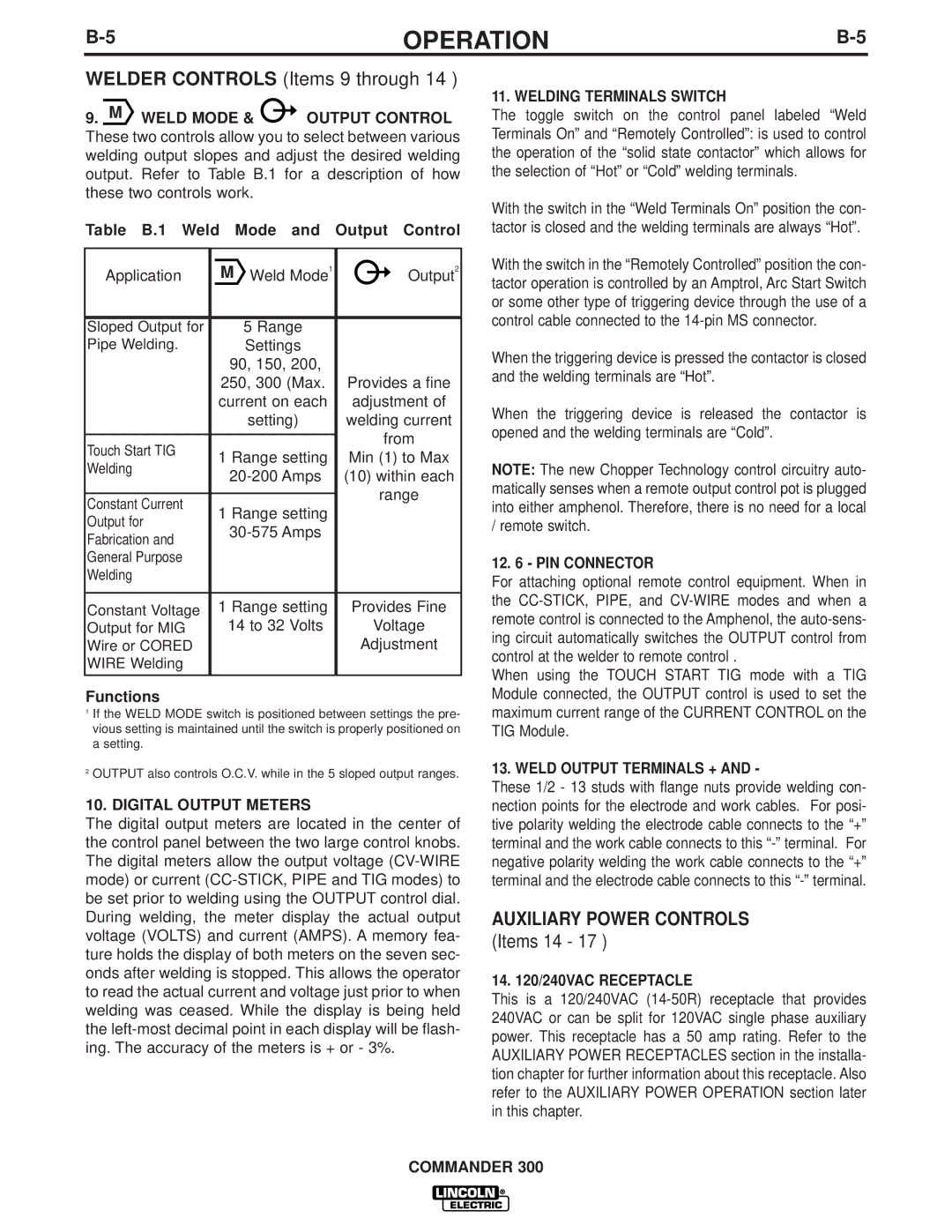
OPERATION | ||
|
|
|
WELDER CONTROLS (Items 9 through 14 )
9. M WELD MODE &  OUTPUT CONTROL
OUTPUT CONTROL
These two controls allow you to select between various welding output slopes and adjust the desired welding output. Refer to Table B.1 for a description of how these two controls work.
Table B.1 Weld Mode and Output Control
Application | M Weld Mode1 | Output2 | |
|
|
| |
Sloped Output for | 5 Range |
| |
Pipe Welding. | Settings |
| |
| 90, 150, 200, |
| |
| 250, 300 (Max. | Provides a fine | |
| current on each | adjustment of | |
| setting) | welding current | |
|
| from | |
Touch Start TIG | 1 Range setting | ||
Min (1) to Max | |||
Welding | |||
(10) within each | |||
| |||
|
| range | |
Constant Current | 1 Range setting | ||
| |||
Output for |
| ||
| |||
Fabrication and |
| ||
|
| ||
General Purpose |
|
| |
Welding |
|
| |
|
|
| |
Constant Voltage | 1 Range setting | Provides Fine | |
Output for MIG | 14 to 32 Volts | Voltage | |
Wire or CORED |
| Adjustment | |
WIRE Welding |
|
| |
|
|
|
Functions
1If the WELD MODE switch is positioned between settings the pre- vious setting is maintained until the switch is properly positioned on a setting.
2OUTPUT also controls O.C.V. while in the 5 sloped output ranges.
10. DIGITAL OUTPUT METERS
The digital output meters are located in the center of the control panel between the two large control knobs. The digital meters allow the output voltage
11. WELDING TERMINALS SWITCH
The toggle switch on the control panel labeled “Weld Terminals On” and “Remotely Controlled”: is used to control the operation of the “solid state contactor” which allows for the selection of “Hot” or “Cold” welding terminals.
With the switch in the “Weld Terminals On” position the con- tactor is closed and the welding terminals are always “Hot”.
With the switch in the “Remotely Controlled” position the con- tactor operation is controlled by an Amptrol, Arc Start Switch or some other type of triggering device through the use of a control cable connected to the
When the triggering device is pressed the contactor is closed and the welding terminals are “Hot”.
When the triggering device is released the contactor is opened and the welding terminals are “Cold”.
NOTE: The new Chopper Technology control circuitry auto- matically senses when a remote output control pot is plugged into either amphenol. Therefore, there is no need for a local / remote switch.
12. 6 - PIN CONNECTOR
For attaching optional remote control equipment. When in the
When using the TOUCH START TIG mode with a TIG Module connected, the OUTPUT control is used to set the maximum current range of the CURRENT CONTROL on the TIG Module.
13. WELD OUTPUT TERMINALS + AND -
These 1/2 - 13 studs with flange nuts provide welding con- nection points for the electrode and work cables. For posi- tive polarity welding the electrode cable connects to the “+” terminal and the work cable connects to this
AUXILIARY POWER CONTROLS
(Items 14 - 17 )
14. 120/240VAC RECEPTACLE
This is a 120/240VAC
COMMANDER 300
